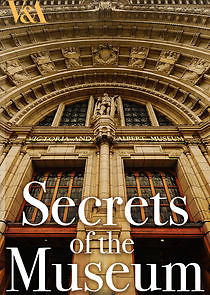|
The curators are searching for untold stories in the museum's objects. Curator Christine is working on a major new exhibition highlighting African fashion, spanning couture, photography and design. But she's also looking for objects with more personal stories. A family has come forward offering their kente cloth to the exhibition. Traditionally made from woven strips of silk and cotton, kente has been produced in west Africa since the 17th century.77-year-old grandmother Gladys tells Christine that she bought her kente in Ghana in 1960, ready for the christening of her daughter Doris. The family are keen to see the precious family heirloom go on display at the V&A.Christine has also taken delivery of a new object for the forthcoming show – a colour photograph by London-based Ghanaian photographer James Barnor. The print, from a photograph taken in 1971, is of a well-dressed woman carrying brightly-coloured bottles, and was used as a guide for the correct reproduction of colour. Barnor established the first colour processing lab in Ghana, but he also documented life in the country as it was becoming independent, as well as capturing the swinging 60s in London. Christine and co-curator Hana invite 92-year-old Barnor in to the V&A.Some of the objects in the V&A's collection are still shrouded in mystery. Curator Nick has recently made a puzzling discovery – an object he's never seen before. Acquired by the V&A in 1855, the large wooden dish or tray was given the attribution ‘Ancient Persian, 17th century', but Nick suspects that may be incorrect. He has a hunch that the highly-decorated tray may be a rare example of a ‘barniz de Pasto' object.There are no more than 20 known barniz de Pasto objects in Europe, and the V&A holds five. Nick wants to find out if they have a sixth.
Barniz de Pasto refers to a style of decoration applied to a range of wooden objects made from the 17th century onwards in the Spanish colonies of Latin America. It's distinguished by a particular kind of varnish applied to the objects, known as mopa mopa.To find out if his tray is indeed varnished with mopa mopa, Nick asks senior conservator Dana to take a small sample from the surface, which is analysed to find out if the molecular signature of mopa mopa is present.Even objects on permanent display have little-known stories to tell. Among the V&A's most celebrated collections are 24 sculptures by Auguste Rodin, on show at the museum since 1914. They include Inner Voice, a bronze statue depicting a young woman lost in her thoughts. Attacked by many critics when it was first unveiled for its daring new approach to the human form, Inner Voice is now considered a masterpiece. The statue is being sent on loan to Switzerland, but before it leaves, curator Melanie wants to uncover the strange story of how so many Rodin works ended up in the museum a century ago.She tracks down correspondence between Rodin and the V&A, and discovers that the artist offered his works to the museum after the First World War broke out. The director of the V&A at the time, Cecil Smith, admitted that he personally detested Rodin's work, and yet he believed the sculptor would in time be recognised for his huge contribution to modern art.In Dundee, curators are turning the page on one of their biggest objects – literally. It's a giant pop-up book made by artist John Byrne, used as a backdrop for a touring stage production of the play The Cheviot, the Stag and the Black, Black Oil, which made a huge impact on audiences across Scotland during the 1970s. The book is on long-term loan from the National Library of Scotland. To protect it from too much light exposure, a team from the National Library and V&A Dundee have devised a plan to carefully turn the page of the huge but fragile pop-up book, revealing a new scene.
|

Running
|



AmieWarren : Just started watching it, but I like more detecting and less sexing. It's o.k., but the on...